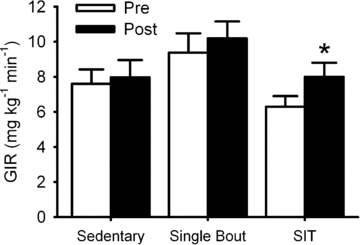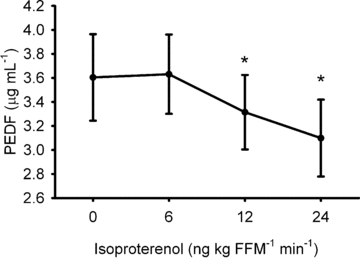Short-term sprint interval training increases insulin sensitivity in healthy adults but does not affect the thermogenic response to beta-adrenergic stimulation
- PMID: 20547683
- PMCID: PMC2956910
- DOI: 10.1113/jphysiol.2010.189886
Short-term sprint interval training increases insulin sensitivity in healthy adults but does not affect the thermogenic response to beta-adrenergic stimulation
Abstract
Sprint interval training (SIT) and traditional endurance training elicit similar physiological adaptations. From the perspective of metabolic function, superior glucose regulation is a common characteristic of endurance-trained adults. Accordingly, we have investigated the hypothesis that short-term SIT will increase insulin sensitivity in sedentary/recreationally active humans. Thirty one healthy adults were randomly assigned to one of three conditions: (1) SIT (n = 12): six sessions of repeated (4-7) 30 s bouts of very high-intensity cycle ergometer exercise over 14 days; (2) sedentary control (n = 10); (3) single-bout SIT (n = 9): one session of 4 x 30 s cycle ergometer sprints. Insulin sensitivity was determined (hyperinsulinaemic euglycaemic clamp) prior to and 72 h following each intervention. Compared with baseline, and sedentary and single-bout controls, SIT increased insulin sensitivity (glucose infusion rate: 6.3 +/- 0.6 vs. 8.0 +/- 0.8 mg kg(1) min(1); mean +/- s.e.m.; P = 0.04). In a separate study, we investigated the effect of SIT on the thermogenic response to beta-adrenergic receptor (beta-AR) stimulation, an important determinant of energy balance. Compared with baseline, and sedentary and single-bout control groups, SIT did not affect resting energy expenditure (EE: ventilated hood technique; 6274 +/- 226 vs. 6079 +/- 297 kJ day(1); P = 0.51) or the thermogenic response to isoproterenol (6, 12 and 24 ng (kg fat-free mass)(1) min(1): %EE 11 +/- 2, 14 +/- 3, 23 +/- 2 vs. 11 +/- 1, 16 +/- 2, 25 +/- 3; P = 0.79). Combined data from both studies revealed no effect of SIT on fasted circulating concentrations of glucose, insulin, adiponectin, pigment epithelial-derived factor, non-esterified fatty acids or noradrenaline (all P > 0.05). Sixteen minutes of high-intensity exercise over 14 days augments insulin sensitivity but does not affect the thermogenic response to beta-AR stimulation.
Figures



Comment in
-
Just HIT it! A time-efficient exercise strategy to improve muscle insulin sensitivity.J Physiol. 2010 Sep 15;588(Pt 18):3341-2. doi: 10.1113/jphysiol.2010.196303. J Physiol. 2010. PMID: 20843832 Free PMC article. No abstract available.
References
-
- Ando D, Hosaka Y, Suzuki K, Yamagata Z. Effects of exercise training on circulating high molecular weight adiponectin and adiponectin oligomer composition: a randomized controlled trial. J Atheroscler Thromb. 2009;16:733–739. - PubMed
-
- Banumathi E, Sheikpranbabu S, Haribalaganesh R, Gurunathan S. PEDF prevents reactive oxygen species generation and retinal endothelial cell damage at high glucose levels. Exp Eye Res. 2010;90:89–96. - PubMed
-
- Bell C, Day DS, Jones PP, Christou DD, Petitt DS, Osterberg K, et al. High energy flux mediates the tonically augmented beta-adrenergic support of resting metabolic rate in habitually exercising older adults. J Clin Endocrinol Metab. 2004;89:3573–3578. - PubMed
-
- Bell C, Kowalchuk JM, Paterson DH, Scheuermann BW, Cunningham DA. The effects of caffeine on the kinetics of O2 uptake, CO2 production and expiratory ventilation in humans during the on-transient of moderate and heavy intensity exercise. Exp Physiol. 1999a;84:761–774. - PubMed
Publication types
MeSH terms
Substances
LinkOut - more resources
Full Text Sources
Medical
Research Materials
Miscellaneous

